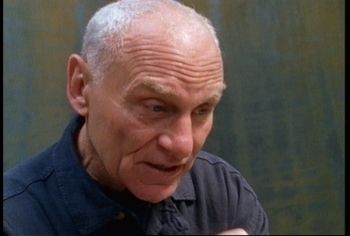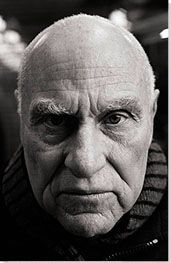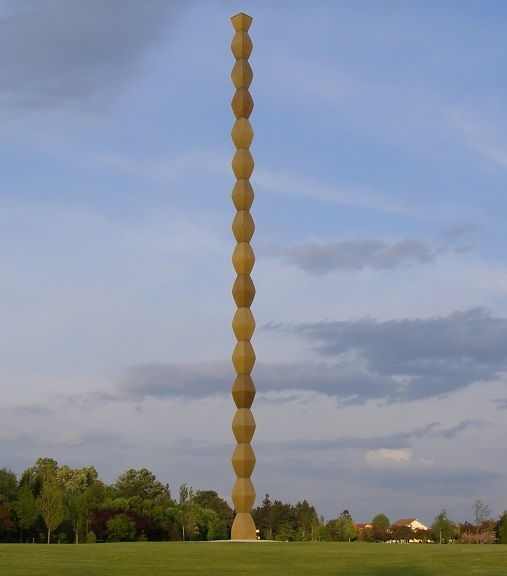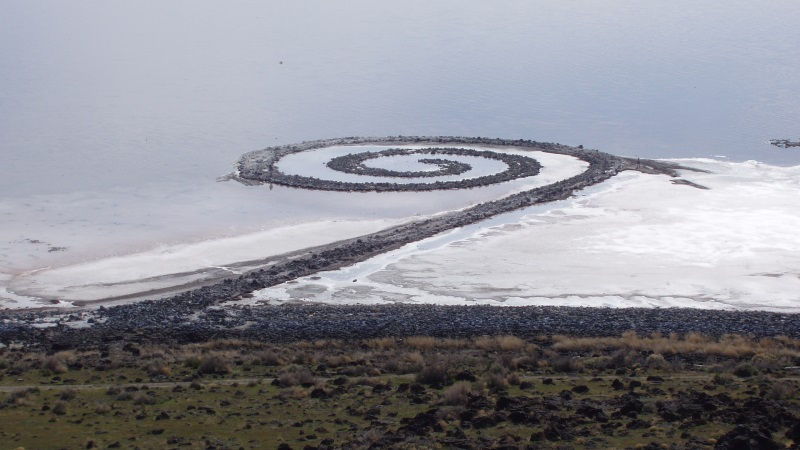Summary of Richard Serra
Richard Serra is one of the preeminent American artists and sculptors of the post-Abstract Expressionist period. Beginning in the late 1960s to the present, his work has played a major role in advancing the tradition of modern abstract sculpture in the aftermath of Minimalism. His work draws new, widespread attention to sculpture's potential for experience by viewers in both physical and visual terms, no less often within a site-specific, if not highly public setting.
Accomplishments
- Coming of age in the shadow of greats such as Constantin Brancusi, Pablo Picasso, and Julio González, Serra both inherited and advanced the tradition of abstract sculpture, adapting the medium of welded steel (originally a concern of early-20th-century Cubism) to new, holistic values of the 1960s and 1970s. More recent Minimalist sculptors, among them Donald Judd and Carl Andre, had demonstrated how sculpture and its materials could stand for themselves, or not be forced to serve as vehicles for articulating an artist's emotional and intellectual life. Serra took up that contemporary heritage, one suggesting that the human body itself no longer had a place in painting or sculpture, and returned to it something of the human body's stature. He explored how an art work might relate intimately to a specific setting; how it might take up a physical as well as a visual relationship to a viewer; and how it might create spaces (or environments) in which a viewer can experience universal qualities of weight, gravity, agility, and even a kind of meditative repose.
- Serra's adaptive sensibility in working collaboratively with, or learning from, contemporary musicians, dancers, and videographers, was part of an era in American art in which artists increasingly explored various disciplines for their overlapping and shared concerns with a new kind of art that might push the viewer's experience beyond the purely visual or optical act towards a fully physical, or "somatic" participation. Serra's work is at once a painting, a sculpture, a piece of architecture, and an epic fragment of modern industry.
- Serra's concern with the implicit relationship between his sculpture's conception and its intended site has led directly to a new international discourse (often a heated one) regarding the role and governance of art in public spaces such as municipal parks, corporate plazas, and memorial sites - where the work of art might virtually interrupt viewers' daily routines in ways that are not necessarily universally welcomed among a given community. Serra's sculpture indeed suggests that art should be something "participatory" in modern society, that is, a gesture, or physical insertion into everyday life, not something confined to a cloistered museum space.
- Serra's materials and methods, i.e. large-scale steel panels and welding, has been interpreted by some feminist historians as a "last gasp" of Abstract Expressionism's so-called masculine themes and artistic processes. His work has thus unwittingly inspired a host of counter-responses by subsequent generations, who, decidedly in rejection of his histrionic example, turned in the late 1970s and 1980s toward more ephemeral, everyday materials to suggest that art could be monumental without relying on massive, "in your face" substances and formats.
The Life of Richard Serra

Serra's sculpted pieces, such as Tilted Spheres shown here inside an airport, are larger than life and trully evoke awe in most passerby. Serra took many years of artistic explorations to arrive at such forms.
Important Art by Richard Serra
Gutter Corner Splash: Late Shift
Gutter Corner Splash marks the debut of Serra's work in metal sculpture and demonstrates his experimenting with the various properties of the medium. Partly inspired by the example of Jackson Pollock and Action Painting, Serra has explained that the Splash series grew out of his interest in an implied, reciprocal relationship between the artist, the work of art, and the subsequent viewer: "I was interested in my ability to move in relation to material and have that material move me." As though Serra were pouring liquid pigments or sketching, Gutter suggests multiple traditions of sculpture, from ancient bronze casting methods to some of the most recent (at that time) reductive concepts of 20th-century Minimalism. The series also demonstrates Serra's evolving interest in site-specificity, as well as his preoccupation with the natural force of gravity, both of which have retained their importance in most of Serra's subsequent work.
Lead - San Francisco Museum of Modern Art
Verb List
Although usually regarded as an artist's statement (akin to a private, reflective diary entry), Verb List might also be regarded as the artist's chronological, aesthetic agenda, setting out his subsequent development in sculpture. If the "to" verbs are thought of as denoting acts already accomplished, and the "of" verbs as connoting those he has yet to undertake, Verb List may also be viewed as a shorthand, visual retrospective of Serra's entire career, compressing past, present, and future into a single material object. Like a map, or a theoretical diagram, Verb List finally "stands in," as a visual and conceptual proxy for something more physically tangible, or virtually touchable: sculpture itself. Serra's later, monumental walls in steel would ultimately come to embody, in more abstract and open-ended terms, what the artist has chosen to conjure here in the "mind's eye" of the beholder, indeed by way of strictly linguistic medium.
One Ton Prop (House of Cards)
Considered in retrospect, One Ton Prop suggests the outcome of Serra's mature works, where various properties of gravity, weight, counterforce, sinuous movement, and other physical and visual properties are embodied by steel, a material commonly assumed the stuff of architectural skeletons rather than objects, in their own right, of visual attention. Arising out of the recent, rather deadpan history of Minimalism, One Ton Prop reintroduces to sculpture a comparatively witty and even whimsical sense of bodily pleasure, each plate of lead leaning gently against the other (who, here, is doing the "hard work" of supporting?) as though in a continuous round-robin of "passing the buck" along to the next guy. One even thinks of a long tradition of visual riddles, such as an endless staircase by the contemporary Dutch graphic artist, M. C. Escher (1898-1972), where it is impossible to ascertain beginning or ending, origin or destination, or (to be cosmic about it) genesis or death. One Ton Prop has also assumed a place in history as a centerpiece in a larger discussion of gender representation in art, ever since one viewer (presumably female) scribbled "DICK ART" on one of its sides, which drew attention to the work's imposing, even "machismo" bravado (this element recalls the recent, largely male-dominated legacy of Abstract Expressionism). The work's reliance on "dangerous" processes of iron welding, along with its large, or monumental scale has often been associated with masculine bravado (as was the former era's obsession with the mural-sized canvas, as though "size always matters"). Other observers, however, find the sinuous, arabesque curves of much of Serra's sculpture notably reminiscent of the female figure.
Lead - The Museum of Modern Art, New York
Tilted Arc
According to its critics, Tilted Arc forced people to walk around, rather than directly across its chosen site of Federal Plaza, in a downtown New York City business district (where indeed global powerbrokers are accustomed to walking in very straight, or goal-oriented trajectories). There can be no doubt, then, that Tilted Arc is Serra's most successful (if ultimately publicly vilified) expression of his underlying desire to incorporate direct viewer participation into the sculptural experience, or his work as an unavoidably material and visual "phenomenon." When asked what he thought people found so problematic in this work, Serra laughed and replied, with typical impatience for too much interpretation over the art work's own "meaning," that it was the curve to which the general public was negatively responding: "They hadn't seen that before. Modernism was at a right angle; the whole 20th century was a right angle." He might as well been referring to the city itself (no less to a large part of 20th-century architectural history), as New York is virtually a methodical grid upon which Serra had, without doubt, boldly trespassed. Tilted Arc indeed traffics in an entire spectrum of "interruptive" experiences, such as a train passing, a ship pulling into harbor, a road sign speaking "DETOUR," or a herculean water dam holding back extremely powerful, natural forces. Indeed, deep beneath Lower Manhattan's own geographies there are industrial walls brutally inserted into the found landscape, so as to reclaim entire portions of the Hudson River for human expansion. It is hardly a wonder, therefore, that Tilted Arc aroused such antipathy in an era unaccustomed to such bold displays of artistic, site-specific intervention.
Weatherproof steel
Snake
Created specifically for the Guggenheim Bilbao, Snake is another example of how the natural and built environment factors into the conception and subsequent experience of Serra's sculpture. The pathways created by each portion of the sculpture direct one's attention to the spaces between them, rather than to the materials themselves. Is not the art work, then, composed of air as well as steel itself? In fact, the winding, narrow routes (to which artists commonly refer as "negative space") and tilted walls of Snake offer a heightened perception of human vulnerability, or physical precariousness, no matter the work's secure grounding. Thus they draw a viewer's attention to the potential instability and danger implied in all structures of astounding tonnage.
Weatherproof steel - Guggenheim Bilbao
Torqued Ellipse
Recalling his experience of Italy, Serra regards his Torqued Ellipse series as a logical conclusion to the architectural problems, or, as it were, visual irresolution, suggested by San Carlo alle Quattro Fontane [Church of Saint Charles at the Four Fountains], a Roman Catholic church dating from the Baroque era, by Francesco Borromini (1599-1667). Although the church's dynamic, undulating facade is recapitulated in the bending walls of Snake, the latter's embracing contours evokes the artist's achievement of security and serenity, after he had long pondered his predecessor's expression, in Travertine limestone, of restless spiritual ambition.
Weatherproof steel - Dia Art Foundation, New York
Biography of Richard Serra
Childhood
Richard Serra was the second of three sons born to a Russian Jewish mother and a Spanish father. As a young boy, he lived with his family amidst the sand dunes of San Francisco. Staying mostly within the boundaries of his home life, he knew little of the outside world, let alone the fine arts. His earliest sparks of creativity came from spending time at the shipyards, where his father worked as a pipefitter.
According to Serra, the foundations of his art took shape on his fourth birthday, during the launch of an oil tanker at the Marine Shipyard in San Francisco: "All the raw material I needed is contained in the reserve of this memory." In particular, he recalled later in life the powerful horizontal curve made by the ship's hull, and the contradictory lightness and speed that impressed him when the vessel took off through the water. It was around this same time that Serra began to draw, an activity that he believes aided the growth of his imagination and sense of invention, as well as provided him with the necessary confidence to recognize his artistic potential.
Early Training
Serra earned a Bachelor's degree in English literature in 1961 from the University of California at Santa Barbara. He had supported himself during his studies by working at a steel mill, an occupation that would come to inform his later work as an artist. Serra continued with his Master's studies at Yale University in 1961, where he was trained in painting with contemporaries Brice Marden, Chuck Close, and others, most of whom he remembers considering, at that time, "more advanced" students. In 1964-65, Serra studied in Paris, where he spent a great deal of time drawing near a reconstruction of Brancusi's studio. Although he later claimed to have known little of the modernist master or the recent history of sculpture at the time, Serra nonetheless acknowledged Brancusi's "authoritative" example.
Serra traveled to Italy the following year, where he began painting a series of grids in random colors. He later learned, by way of a recent issue of Art News, that Ellsworth Kelly was painting in a similar style, so Serra abandoned the technique. During a side trip to Spain, Serra's viewing of Velásquez's Las Meninas made him realize he was dissatisfied with the two-dimensional limitations of painting. The event virtually changed the course of Serra's artistic career; soon searching for an alternative direction, he began creating works using live and, in other instances, stuffed animals in cages. After incorporating live animals in his first solo show at Galleria La Salita, Rome in 1966, the public uproar was so great that the venue was promptly shut down by the local police.
Mature Period

On his return to the United States in 1966, Serra settled in New York, where he began making his first sculptures out of rubber-said to have been inspired by the horizontal progression in Jackson Pollock's painting, Mural (1943). Between 1968 and 1970, Serra worked on his Splash series, which were semi-sculptural works derived from the artist's splashing molten lead onto the spatial junction, or gutter, where the vertical studio wall conjoined with the horizontal floor plane. Serra's "gutter" works, as well as others by contemporaries whose work similarly highlighted a confluence in their work of action, environment, and medium, soon came to be classed by critics and art historians as Process Art.
The following Prop series, which Serra began in 1969, may be considered the immediate precursor of the enormous metal works for which the artist is today best known. Explorations of balance, weight, and gravity, the Props are perhaps also the beginnings of Serra's recall of his childhood memories of the oil tanker skimming the surface of the ocean.
In 1970, Serra assisted friend and artist Robert Smithson in the latter's execution of the Environmental work, Spiral Jetty. Serra's exposure to Environmental art in this instance reinforced the idea of site-specificity, or the phenomenon of a work of art being conceived and executed as an integral part of its surroundings (this had been implied, if subtly, in the Splash series). Increasingly working in larger formats, Serra developed a growing interest in the spaces created (or otherwise highlighted) by the art work itself, as well as the work's physical, as well as visual relationship to the viewer. This can be seen in Serra's Spirals and Ellipses, works that invite the viewer to participate in their environment by walking around the work and experiencing it through bodily (i.e. somatic) as well as through visual perception.
Such themes, along with others, continue to run through Serra's work to this day. Most of his current large-scale works are welded in Cor-Ten steel, although Serra notably distances himself from the "heroic" status of Pablo Picasso, Julio González, and David Smith, who were modernist pioneers in the mastery of welded sculpture.
Serra also experimented with video art as early as the late 1960s, producing his first of many video art films, Hand Catching Lead, in 1968. Hand features the artist repeatedly trying to catch pieces of lead falling from the top of the frame. Serra describes his films as providing a supplementary understanding of his sculpture, and he has since made several others that showcase metal, and in particular his favorite medium of steel.
During his early years in New York, Serra similarly became involved with music and dance. Recognizing that the factors of space and balance so characteristic of works in music and dance were similar to his own in sculpture, Serra collaborated in performances and installations with Yvonne Rainer, Stephen Reich, and Joan Jonas. Perhaps in tribute to his musical roots, Serra has been mentioned in Vampire Weekend's song, White Sky, and his art has been featured on the cover of the Monoliths & Dimensions album by Sunn O))).

In 1981, a civic controversy attending the public installation of Serra's Tilted Arc, in lower Manhattan's Federal Plaza (in front of the Javits Building), assumed the status of a notorious footnote in Serra's career. The installation of the commissioned work provoked vociferous, negative outcry from area office workers, who regarded Tilted Arc as little more than an ugly monstrosity, no less one attracting graffiti and litter. The escalating protests against Tilted Arc drew so much international attention that the municipal government was compelled to hold a series of public hearings on the matter, during which Serra testified-in recall of his belief in his art work's site specificity - that "to remove the work is to destroy it." The incident set off a wider, international debate about contemporary art in public spaces and the role-indeed power-of public opinion. In fact, the hearings resulted in a court decision to have Titled Arc permanently removed from its site. Serra appealed the decision, to little immediate effect: the sculpture was ultimately dismantled and carted off from Federal Plaza in 1989.
The Legacy of Richard Serra
Serra is widely considered one of the most influential sculptors of the late-20th century. A modern Renaissance man with a forceful personality, Serra's interest in painting, sculpture, music, dance, film, performance, and installation art has affected legions of artists during his long career. Architects and urban planners today often cite Serra's influence, which the artist scorns in keeping with his belief that true art is never utilitarian. As evidenced forcefully by Tilted Arc, Serra's work is, at any rate, difficult to ignore and has been important in moving the discourse about public art to the critical forefront. His work has inspired the founding of a public art program at the University of California (in his hometown of San Francisco), and Serra has himself supported the development of sculpture parks across the United States.
Influences and Connections

-
![Frank Gehry]() Frank Gehry
Frank Gehry -
![Matthew Barney]() Matthew Barney
Matthew Barney ![Kirk Varnedoe]() Kirk Varnedoe
Kirk Varnedoe
-
![Post-Minimalism]() Post-Minimalism
Post-Minimalism ![Process Art]() Process Art
Process Art
 Ask The Art Story AI
Ask The Art Story AI





























